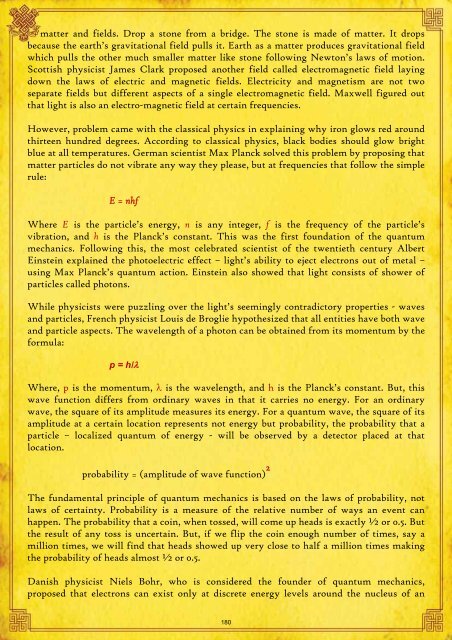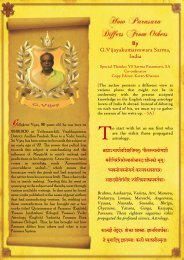SAVol7Dec09WesternCo.. - Saptarishis Astrology
SAVol7Dec09WesternCo.. - Saptarishis Astrology
SAVol7Dec09WesternCo.. - Saptarishis Astrology
You also want an ePaper? Increase the reach of your titles
YUMPU automatically turns print PDFs into web optimized ePapers that Google loves.
matter and fields. Drop a stone from a bridge. The stone is made of matter. It dropsbecause the earth’s gravitational field pulls it. Earth as a matter produces gravitational fieldwhich pulls the other much smaller matter like stone following Newton’s laws of motion.Scottish physicist James Clark proposed another field called electromagnetic field layingdown the laws of electric and magnetic fields. Electricity and magnetism are not twoseparate fields but different aspects of a single electromagnetic field. Maxwell figured outthat light is also an electro-magnetic field at certain frequencies.However, problem came with the classical physics in explaining why iron glows red aroundthirteen hundred degrees. According to classical physics, black bodies should glow brightblue at all temperatures. German scientist Max Planck solved this problem by proposing thatmatter particles do not vibrate any way they please, but at frequencies that follow the simplerule:E = nhfWhere E is the particle’s energy, n is any integer, f is the frequency of the particle’svibration, and h is the Planck’s constant. This was the first foundation of the quantummechanics. Following this, the most celebrated scientist of the twentieth century AlbertEinstein explained the photoelectric effect – light’s ability to eject electrons out of metal –using Max Planck’s quantum action. Einstein also showed that light consists of shower ofparticles called photons.While physicists were puzzling over the light’s seemingly contradictory properties - wavesand particles, French physicist Louis de Broglie hypothesized that all entities have both waveand particle aspects. The wavelength of a photon can be obtained from its momentum by theformula:p = h/λWhere, p is the momentum, λ is the wavelength, and h is the Planck’s constant. But, thiswave function differs from ordinary waves in that it carries no energy. For an ordinarywave, the square of its amplitude measures its energy. For a quantum wave, the square of itsamplitude at a certain location represents not energy but probability, the probability that aparticle – localized quantum of energy - will be observed by a detector placed at thatlocation.probability = (amplitude of wave function) 2The fundamental principle of quantum mechanics is based on the laws of probability, notlaws of certainty. Probability is a measure of the relative number of ways an event canhappen. The probability that a coin, when tossed, will come up heads is exactly ½ or 0.5. Butthe result of any toss is uncertain. But, if we flip the coin enough number of times, say amillion times, we will find that heads showed up very close to half a million times makingthe probability of heads almost ½ or 0.5.Danish physicist Niels Bohr, who is considered the founder of quantum mechanics,proposed that electrons can exist only at discrete energy levels around the nucleus of an1802
















